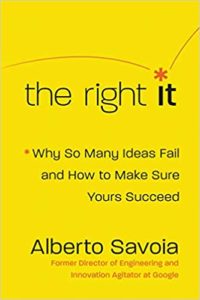Since last year, I’ve read plenty of books on the topic of innovation management, startups and business models. Among them classics like Eric Ries’ lean startup or the innovation dilemma from Clayton Christensen. Good basics, no doubt, but the books that really impressed me to the level that I can say they are pieces of literature that change the way one thinks are the following:
- Building the right it from Alberto Savoia

- Cross-industry innovation from Ramon Vullings and Marc Heleven

- The online book from Simon Wardley about wardley maps
The book from Alberto Savoia (ex-Google “innovation agitator”) THE book about pretotyping. Pretotyping is the concept to validate that one builds the right “it” (e.g. product or service) before thinking and spending a lot of time, money and effort in defining how to build the product (building it right). All too often we start by building a prototype of a product and then try to verify it in the market. But even building a prototype is sometimes quite some effort, especially in bigger corporations. Pretotyping tries to make the validation of product-market fit before building a prototype with minimal cost (metric dollar to data, $TD), minimal time (hours to data, HTD) and minimal effort (distance to data, DTD). Alberto presents some, after you’ve heard it, obvious tools like market engagement hypothesis (MEH), XYZ hypothesis, hypozooming and the importance of collecting your own data (YODA). A must read, valuable for each innovator from the first to the last page! If I’d only had read this book before delving into the world of startup.
The small cross-industry innovation book is more a collection of pointer to ideas and lots of example of how to translate concepts that are established in one domain or part of an industry into a seemingly completely unrelated other industry. This is something that I already did several times in my life, so this book was a late confirmation that this type of innovation is really a very valid and relevant one and not just a dump tactical technique.
Especially in industries, like manufacturing, that seem years behind other areas of IT, this is a very interesting source of innovation. I do think though that it requires a extremely open mind and is not easy, if one is deeply involved in a domain. Being an expert, say in manufacturing or logistics, probably makes it very hard to recognize that there are shortcoming in areas that you take for granted, that have long been solved in other domains.
Finally the best, Simon Wardley with his wardley maps. Not yet a book, only a series of online blog articles but probably the most significant contribution to thinking about and visualizing strategy, that I’ve ever seen. He thinks so differently but sharp like a knife, that you have to be alert when reading the articles every minute, in order not to miss one of the important points. I would rate this work as one of the epocal ones and most inspiring that I’ve ever read.
And guess what, I’ve started to use wardley maps immedately to map out the innovation landscape or solutions at work in order to understand them. But I have to say, it is somewhat difficult to create maps that other understand without explanation. One automatically creates the maps based on the own way of thinking, which might not be how others look at such a “landscape”. So it is an extremely valuable basis for having a conversation or explanation but can’t just be forwarded without adding words by mail.
So, Simon Wardley’s articles and videos (youtube) are an absolute MUST READ for someone that is trying to find tools for detecting opportunities and evaluate innovations.
Leave a Reply
You must be logged in to post a comment.